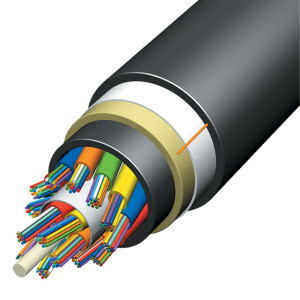Designs of Optic Fiber Cables
 Optical fiber cabling is made up of a fiber core and a protective layer. The shield is typically coated with a polymer. It protects the cable from damage and does not contribute to optical wave guide properties. The coated fiber is a durable synthetic resin serving as a support for the cable’s core. Protective jacket layers are added depending on the cabling application.
Optical fiber cabling is made up of a fiber core and a protective layer. The shield is typically coated with a polymer. It protects the cable from damage and does not contribute to optical wave guide properties. The coated fiber is a durable synthetic resin serving as a support for the cable’s core. Protective jacket layers are added depending on the cabling application.
Fiber over Copper
Fiber has benefits over copper. Fiber optic transmission does not emit Radio Frequency Interference or RFI. This guarantees secured communications since light waves can’t be easily intercepted. On the contrary, copper wires give off signals that interfere with other electronic equipment. That is why utility firms now run power lines with fibers implanted in the wires for efficient communications and network management. Increased bandwidth or distance concerns generally push users to use fiber cables.
With contemporary applications, multi-mode fiber is used at from 100 up to 1000 Megabytes. Single mode fibers ensure practically unrestricted bandwidth especially with the use of dense wavelength multiplexing. For covered applications, jacketed fiber is usually enclosed with a bundle of flexible fibrous polymers. This is in the form of a lightweight plastic cover that forms a simple thin cable. Both ends of the cable may be terminated with special connectors. These allow easy connection and disconnection from transmission and receiving switches and patch panels.
Fiber Optic Communications
Fiber optic linkages represent the communications conduit between devices. A particular link has signals diffused in two directions and two separate fibers. The most inexpensive design is to make use of two fibers. The link hooks up electronic signals from a couple of devices that must communicate. The principle is similar to the copper cable. It contains a transmitter which is responsible for converting the signals from communications apparatus to optics. On the other end, the receiver transmits the signal back to the electronics at the opposite point.
Optical Fiber for Rigid Environments
The “breakout” optical fiber cable is generally utilized in what is described as more demanding environments. Breakout cables contain a ripcord, two non-conductive dielectric members (glass rod epoxy), heat-resistant synthetic yarn, and 3 millimeter buffer tubing with an extra layer of Kevlar around the fiber. Fiber units are grouped with steel strength members to decrease stretching. Modern cables have different shields and armor which have been designed for applications like underground gutters, dual-function power lines, conduit installations, and even outdoor installations along paved thoroughfares.

